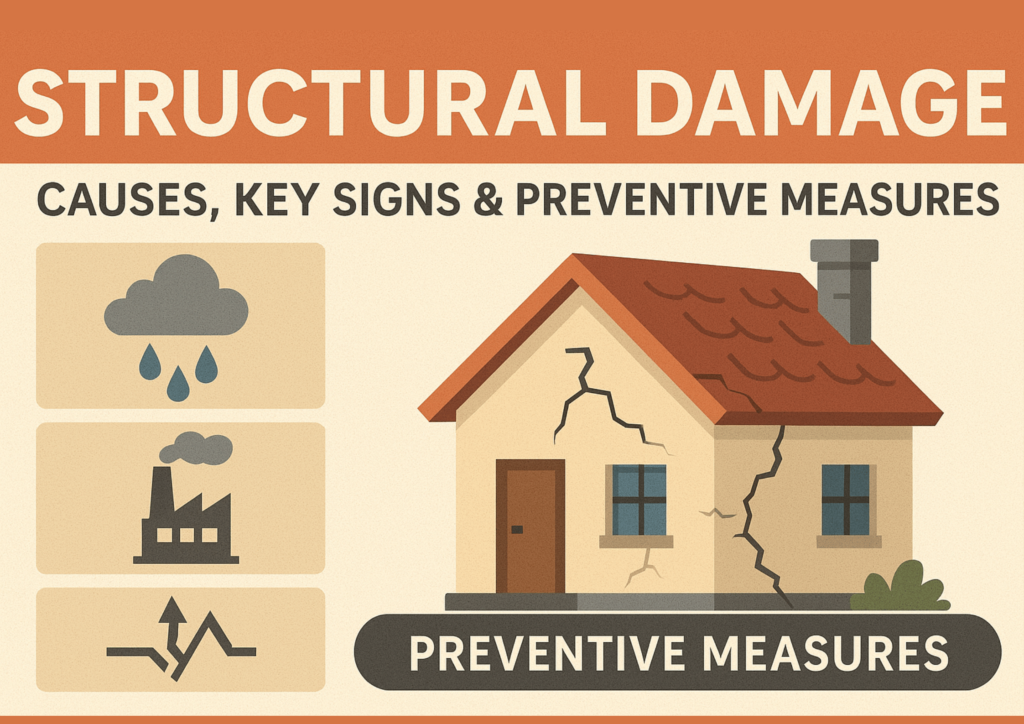
Maintaining the structural integrity of any building is crucial for safety, longevity, and value. As a construction partner, SP Constromate is committed to helping property owners recognize risks early and adopt the best preventive practices.
What Causes Structural Damage?
Understanding the various factors that lead to structural deterioration can help in taking timely action. Common culprits include:
- Design Errors: Inadequate calculations, poor structural analysis, or inappropriate materials selection during the design phase may compromise a building’s strength and stability.
- Construction Defects: Faulty workmanship, use of substandard materials, or improper installation procedures weaken the integrity of structures.
- Material Failure: Concrete spalling, steel corrosion, wood rot, and other material degradations reduce a structure’s load-bearing ability.
- Overloading: Excessive loads from heavy machinery, improper use, or accumulation of snow/water can strain components beyond their capacity.
- Natural Disasters: Events such as earthquakes, floods, and hurricanes can cause acute or long-term structural faults, especially if the building is not designed for such stresses.
- Foundation Issues & Settlement: Uneven soil settlement, erosion, or poor drainage can lead to uneven sinking and cracks in the structure.
- Chemical & Environmental Exposure: Chemicals (chlorides, sulfates) and repeated wetting/drying accelerate corrosion and deterioration of building materials.
Key Signs of Structural Damage
Spotting problems early allows for prompt and cost-effective repairs. Be vigilant for these warning signs:
- Cracks in Walls, Ceilings, or Foundations: Horizontal, vertical, or diagonal cracks, especially wider than 1/4 inch, often signal serious issues such as foundation movement or structural stress. Watch for stair-step patterns in brickwork and cracks that grow over time.
- Sloping or Uneven Floors: Changes in floor level, sunken basements, or misaligned tiles may indicate movement below the surface.
- Doors and Windows that Stick: Difficulty opening or closing, or visible gaps around doors/windows, can result from settling or shifting walls and frames.
- Water Leaks, Dampness, or Seepage: Persistent moisture spots, ceiling stains, or mold may point to failures in structural waterproofing or drainage, possibly leading to underlying damage.
- Spalling or Flaking Concrete: Chipping or flaking of concrete surfaces, often due to internal corrosion of steel reinforcement or freeze-thaw cycles.
- Bulging Walls or Buckling Beams: Deformations in walls or beams can indicate severe internal stresses, overloading, or foundation failure.
- Visible Deterioration: Rust, exposed rebar, delaminated plywood, or wood rot are all visible indicators of ongoing degradation.
Preventive Measures for Structural Damage
Proactive maintenance and smart building practices are the strongest defenses against costly structural issues:
- Routine Inspections: Schedule annual or biannual professional assessments focusing on foundations, major load-bearing elements, and areas prone to water exposure.
- Address Minor Issues Promptly: Regularly check for and repair cracks, leaks, or dampness before they worsen.
- Quality Control During Construction: Use only certified materials and ensure all work follows established codes and engineering standards.
- Monitor Foundation and Drainage: Maintain proper slope around the structure and ensure all gutters, downspouts, and landscaping encourage effective drainage.
- Control Loading: Avoid excessive loading on floors, roofs, and balconies. If altering structural layouts or adding heavy equipment, consult a structural engineer first.
- Environmental Protection: Apply protective coatings to steel and concrete, monitor for chemical exposure, and manage vegetation near foundations to avoid root intrusion or trapped moisture.
- Post-Disaster Assessments: After major storms or seismic events, conduct special inspections to detect hidden damage.
- Keep Documentation: Record all maintenance, repairs, and inspections to track building history and facilitate future evaluations.
Conclusion
Structural damage is often preventable with timely awareness and proactive care. By recognizing key causes, staying alert for the early warning signs, and implementing thorough preventive measures, property owners can safeguard their investments for years to come. For detailed inspections and professional support in Odisha, trust SP Constromate’s expertise in construction and building maintenance.
